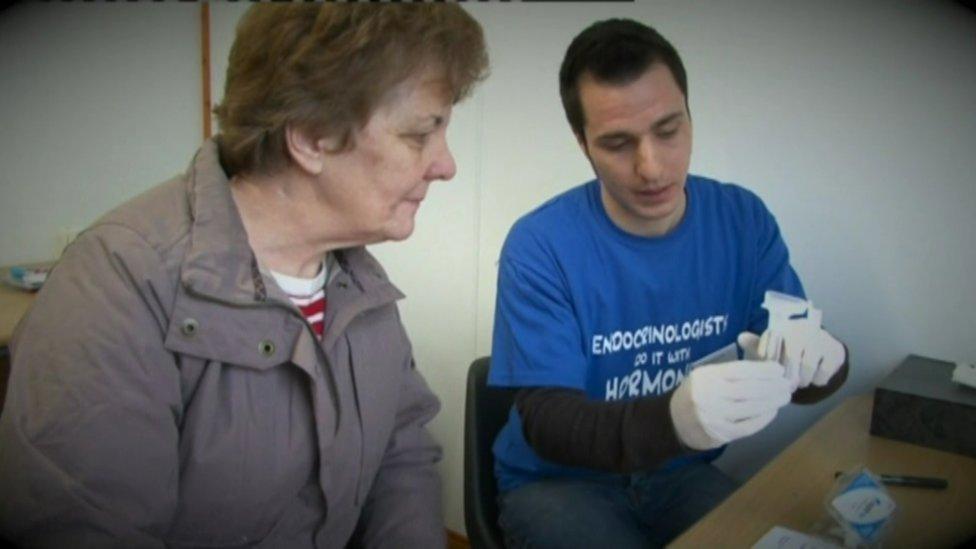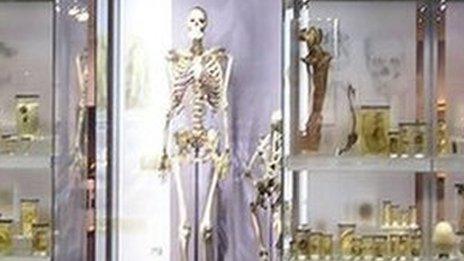Mid Ulster identified as 'giant hotspot' by scientists
- Published
Brendan Holland, who was 6ft 11 at his tallest, has been treated for gigantism
An area in Northern Ireland has been identified as a "giant hotspot" by scientists studying a gene defect which causes people to grow abnormally tall.
One in 150 people in Mid-Ulster were found to carry the gene, compared to one in 1,000 in Belfast and one in 2,000 in the rest of the UK.
More than three-quarters of carriers will never develop health issues, but it can cause long-term problems and be potentially life-threatening for those that do.
Scientists hope the work will help find those at risk of passing on the gene.
The gene - called AIP, but known as the "giant gene" - can result in too much growth hormone, which is produced and released by the pituitary gland, a pea-sized gland just below the brain.
The excessive production occurs as the result of a non-cancerous tumour in the gland.
The condition, called acromegaly or gigantism, can be successfully treated with brain surgery and medication.
Large hands
A screening programme for the gene was undertaken in Magherafelt, Cookstown and Dungannon in 2013.

Many people are unaware they are carrying the gene
The genetic mutation has been found in more than 400 people, and at least 15 families in Northern Ireland have been identified as carriers.
Dr Steven Hunter, an endocrinologist at the Royal Victoria Hospital in Belfast, said only 20% of carriers will develop symptoms.
"It can present with tall stature and people growing excessively tall at a young age," he told the BBC.
'Life-threatening'
"It can also cause problems with growth of the hands and feet in older people and it's associated with problems related to headache because of the growing tumour in the brain and affects eyesight as well.
"We've also seen people with other hormonal problems and infertility.
"It can be life-threatening, but in many cases it's disfiguring."
There are effective treatments and the emphasis was on early diagnosis, he said.
The gene caused Charles Byrne, born in 1761 near Cookstown and known as the "Irish giant", to grow more than 7ft 6in (2.3m) tall.
He became an object of curiosity after travelling to London to seek his fortune before his death in 1783.

Mr Holland with the skeleton of his ancestor Charles Byrne
Geneticists have identified that Mr Byrne and the living carriers of the gene shared a common ancestor who lived about 2,500 years ago.
Brendan Holland, from Dungannon, is 6ft 9in (2.1m) and a distant relative of Byrne.
"It may not please the romantic in some people, but those who are afflicted with this condition probably won't object to the end of this condition," he said.
"I've been lucky, I've actually been cured and had the best treatment available.
"My mother passed the gene to me and she never knew that and many people still to this day are passing the gene on without knowing it."
'Miserable life'
Belfast clinical genetics consultant Prof Patrick Morrison said most people have the wrong perception of giants, believing they are "very fit and athletic and would make great basketball players".
"It's a miserable life for a giant, actually," he said.
"If you're nearly 7ft (2.1m) in height your heart doesn't work so well, you can have heart failure. Your pituitary gland can cause vision problems, you're actually quite weak.
"Maybe by your mid to late 20s you've a lot of problems and a lot of these giants will die in their late 20s if not treated."
The research into the population screening in Mid Ulster was led by Marta Korbonits, professor of endocrinology at Barts and the London School of Medicine Queen Mary.
Prof Korbonits discovered the genetic link for the mutation of the Irish giant gene.
The scientists hope that their work will help to identify those at risk of passing on the gene to future generations and will lead to earlier diagnosis.
- Published8 February 2013
